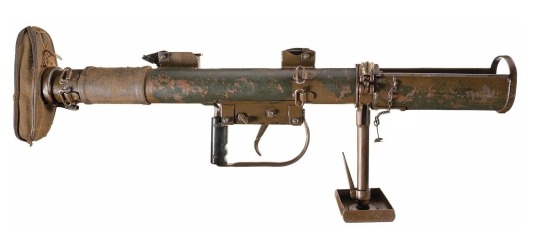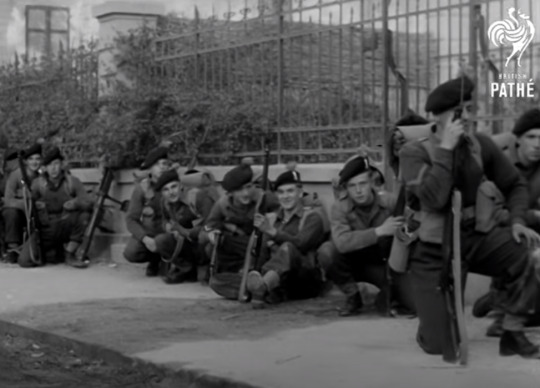#suez fusilier
Note
Do you have a favorite colorful fish, fish giver? :3
I don’t know about favorite but i am real fond of this lil guy

You get a Suez Fusilier
Caesio suevica
48 notes
·
View notes
Photo


The PIAT at Ismailia
This still from a British Pathe newsreel about the battle for the Ismailia Governorate building and Egyptian Police barracks (Bureau Sanitaire) in January 1952, during an escalation of the tensions due to the British occupation of the Suez Canal Zone. This footage represents one of the last operational uses of the Projector, Infantry, Anti-Tank (PIAT). At the time it was beginning to be replaced by the US M20 3.5in ‘Super Bazooka’.
The British Army had garrisoned the Suez Canal Zone since the end of the Second World War and were subject to regular low level attacks. With increasing pressure from the Egyptian government to withdraw from the zone tensions rose further when the 1936 Anglo-Egyptian defence treaty was repealed. The British called on Egyptian police stationed in Ismailia, whom were allegedly responsible for some of the attacks on British troops, to surrender their weapons on 25th January 1952. The police refused and fighting around the police barracks broke out.

The rest of the platoon are armed with a mix of Rifle No.4s and Sten MkVs (source)
Men of the 1st battalion, Lancashire Fusiliers, along with elements of the 4th battalion, Royal Tank Regiment, surrounded the police barracks - with 800 police inside. In the still above men of the Lancashire Fusiliers await orders. There leaning against the wall is a platoon’s PIAT. It’s unclear if the PIAT was used during the fighting around the barracks, one of the weapon’s secondary roles was ‘house breaking’ essentially breaching holes in walls, but with armoured cars and Centurion tanks of the Royal Tank Regiment it is unclear if it would have been needed.
The barracks were bombarded and attacked by the Lancashire Fusiliers suffering three killed and 13 casualties during an assault. Following another bombardment the Egyptian police suffered 41 killed, 73 wounded, and a further 886 surrendered. In 1955 the British army began pulling out of the Canal Zone but would soon return. The PIAT was officially declared obsolete in the summer of 1956, just as the Suez Crisis loomed.
Sources:
Ismailia; Army Seize Police H.Q. (1952), British Pathe, (source)
Suez Canal Zone, National Army Museum, (source)
Egypt (British Military Action, Ismailia), 31 January 1952 vol 495, UK Hansard, (source)
If you enjoy the content please consider supporting Historical Firearms through Patreon!
#History#Military History#PIAT#Ismailia#Cold War#Post Colonialism#Projector Infantry Anti Tank#Guns#gunblr
34 notes
·
View notes
Photo

La prima foto mostra il memoriale dedicato a Robert Burn Anderson, tenente del 1° Bombay Fusiliers, morto prigioniero in Cina nel 1860, dopo essere rimasto per tre giorni legato sotto il sole senza cibo e acqua, insieme ad altri quattro prigionieri. Le sue ceneri riposano in Russia e questo memoriale testimonia di quel gusto ottocentesco per il Medioevo e il neo-gotico. Nelle foto successive, il memoriale al 74° Highlanders, che combatté alla battaglia di Tell al-Kebir, in Egitto, nel 1882. La battaglia coinvolse l'esercito egiziano, guidato da Ahmad 'Urābī, e il corpo di spedizione britannico, comandato dal generale Garnet Wolseley. La tattica di Wolseley consentì ai britannici di cogliere di sorpresa il nemico. La vittoria fu molto importante, perché permise all'Impero britannico di controllare l'Egitto, nominando una sorta di governatore, Lord Cromer, e istituendo il Protettorato britannico, che durò fino al 1922. L'Impero si assicurò così il controllo del canale di Suez, anche dopo la seconda guerra mondiale, fino al 1956. Scoprire o riscoprire queste e altre storie mi affascina. Sempre. Che si tratti di grandi imprese o di eventi più modesti. C'è un qualcosa di inesprimibile e non detto in tutte queste azioni, che conducono a monumenti, a trattati, a nuove spinte per il progresso o per la degenerazione, tanto dei popoli quanto delle singole persone. C'è così tanta vita anche di fronte a una lapide, a un memoriale, a un'iscrizione. E tutto questo intrigo internazionale e umano è talmente denso, che tutto ciò che possiamo dire è poco più che una scalfittura della superficie delle nostre esistenze. #picoftheday #pictureoftheday #photooftheday #photography #uk #scotland #scotland_insta #scotlandlover #scotland_lover #glasgow #glasgowcathedral #stmungocathedral #cathedralsquare #traveler #traveladdict #travelgram #travelblogger #traveling #travelphotography #writer #writers #writerofinstagram #writersofinstagram #writerlife #writersociety #pordenoneviaggia #pordenoneviaggia2019 #ifb #sdv #argyrosingh (presso St. Mungo’s Cathedral) https://www.instagram.com/p/B1CKw39hcvC/?igshid=scbaey396fti
#picoftheday#pictureoftheday#photooftheday#photography#uk#scotland#scotland_insta#scotlandlover#scotland_lover#glasgow#glasgowcathedral#stmungocathedral#cathedralsquare#traveler#traveladdict#travelgram#travelblogger#traveling#travelphotography#writer#writers#writerofinstagram#writersofinstagram#writerlife#writersociety#pordenoneviaggia#pordenoneviaggia2019#ifb#sdv#argyrosingh
0 notes
Text
Tuesday 10 September 2019 Ypres and surrounds
Today is a WWI day. At breakfast we were joined by Danielle Roubroeks, who is accompanying us today. Danielle takes a big interest in the commemorative WWI and WWII events in the region, and has a website www.rememberingmysoliders.be which reflects her talent and passion as a commemorative photographer. I have been introduced to her by friends back in Australia. Last year, she visited several cemeteries to take photos of headstone for my Christ Church South Yarra WWI memorial book. So I had pleasure of giving her a copy of that book (and a few others). Rod was also happy as Danielle is doing the driving today so he can sit back and enjoy the scenery.
We are doing a rather circular tour today around the region. The first place was to drive to Tyne Cot Cemetery which is the largest CWGC in Belgium with 12,000 graves. We arrived about 9am and had this huge cemetery to ourselves in the morning sun. Here is another Solomon family man: Lieutenant Ralph Edward Fulton Barnett, 8th Battalion Lancashire Fusiliers attached 125th Coy Machine Gun Corps. Parents: Sir Louis Edward Barnett and Mabel Violet born in Dunedin, NZ. With prior military experience at Christ’s College Cadets, Christchurch, New Zealand, he arrived in England and was appointed a 2nd Lieutenant on 26 April 1915. He was at Gallipoli from 24 October 1915. In the Suez Canal zone with the 125th Brigade MG coy from 13 March 1916. Promoted to Lieutenant on 1 December 1916. He arrived in France in 28 February 1917. He died 6 September 1917, aged 21. On that day his unit carried out an unsuccessful attack on German pillboxes around Iberian, Borry, and Beck House farms during the Third Battle of Ypres. The Unit dairy notes he was involved in the attack on Beck House, which was initially successful. He was wounded on ‘consolidation’. His service record states he was last seen after his guard had been mounted. Proceeding to report to the commanding officer of the nearest infantry battalion he was shot in the stomach. The small amount of ground his troops took was given up the next day due to a heavy counter attack.
We then drove south to Mesen - known to Australians by its 1917 name of Messines. On the way we stopped briefly at the Burr Cross Cemetery on the Menin Road to pay our respects to Private Harry Huntsman. An OW and the uncle of a good friend of our family.
At Mesen/Messines we did some investigation work for a proposed Ross Bastiaan plaque to honour Captain Robert Grieve VC (OW 1904).
South of Mesen is the Ploegsteert Memorial. On Panel 1 is the name of the nephew of my great grandfather – so a cousin to me. My only family member, that I am aware of, killed in WWI. The register records him as: POWELL, Private, WILLIAM EDWARD, G/9533, MM, 1st Bn., The Queen's (Royal West Surrey Regiment). 13 April 1918. Age 21. Son of William Powell; husband of Amelia Powell (nee Moore), of 24 Russell St., Battersea Park Rd., London. In April 1918, the Germans launched several offensives as to break the Allied lines before the Americans got to full strength and using troops freed up from the Russian front. I suspect he was in the Battle of the Lys see https://en.wikipedia.org/wiki/Battle_of_the_Lys_(1918). His battalion was part of the 33rd brigade. The AIF 1st Division was in this action and famously stopped the Germans on the 12/13 April 1918 outside Hazebrouck.
We then visited and walked into the nearby Ploegsteert Wood. I visited here a couple of years ago and wanted Rod to see this area – especially the cemeteries in the wood. It is also the area of the 1914 Christmas truce.
We then drove onto France to the village of Outtersteene where is the grave of Private Alwyn Horace James Newbery, AIF 20th Battalion. He is the relation of Kerrie, the wife of my first cousin Robert H. I said I would visit his grave if I could; and we were pleased to place a poppy on his grave from his family. A veteran of Gallipoli, he died of wounds following a wound to the thigh on 29 March 1918. He had been wounded three times before: 5 August 1916 - probably at Pozieres/Monquet farm; 3 May 1917 - probably Second Battle of Bullecourt and 9 October 1917 - third Battle of Ypres. He had just come back from the UK after his October 1917 wound. The 20th Battalion at the end of March 1918 was in support of lines around Wulverghem, Belgium. One company was on the Messines Ridge, the Unit diary does not indicate any major action or incidents that day - it was probably a random shot/bomb that wounded him. However, we noted a number of other casualties around that date, so I took some photos of these names as further research might throw for light on the circumstances of his death.
After a baguette and drink in a local café we then drove to the Godewaersvelde British Cemetery. Here is Private Arthur Pittman, AIF 58th Battalion. Aged 22 when he died of wounds 14 October 1917 received two days earlier. Last year I published a booklet on the 29 men on the WWI memorial at Christ Church South Yarra, a church associated with my primary school days. Arthur was a Sunday School teacher there. He arrived in France 15 May 1917. His direct officer in his Red Cross file says he was doing fatigue work at Westhoek ridge when wounded badly by a shell. This cemetery is located in a pretty undulating area near to a hill called Mont-de-Cats. It was a casualty clearing site, and typical of such places most headstones are very close together.
At the Vlamertinge New Military Cemetery is the grave of Captain Roy Blashki. He is associated with the Solomon family. Went to Sydney Grammar School. Embarked from Australia on 10 August 1915. Killed in 3 August 1917 in Belgium. Some loose rounds of ammunition, near a stack of shells, caught fire. One of the gunners ran to put them out and Roy followed him. A shell burst to the right of him killed him instantaneously. His Commanding Officer wrote: Ammunition may be replaced, but not a splendid man as he had proved himself time after time. He was one of the most sterling and conscientious men I ever had anything to do with. http://www.woollahra.nsw.gov.au/library/local_history/world_war_1_remembered/shared_stories
In a couple of rows behind him I noticed was the grave of a Captain WJ Knox, the grandfather of the former Premier of Victoria, Ted Baillieu.
This was the end of my list of to-dos for the day, so as we had some time, Danielle drove us to the German cemetery, north of Ypres at Vladslo. A place of low headstones and towering trees and sculptures – one would think it is a pleasant park – but it contains 25,000 burials. Our final visit was a small CWGC cemetery called Coyne Valley, now located an now industrial area.
Arriving back at our hotel we had a drink before paying a visit to the Menin Gate to finalise some research.
Dinner at a excellent restaurant and then we said farewell to Danielle at about 9.15pm. It’s been a very busy day – great to have a local with many insights and stories to tell of the region. Thank-you Danielle.
0 notes